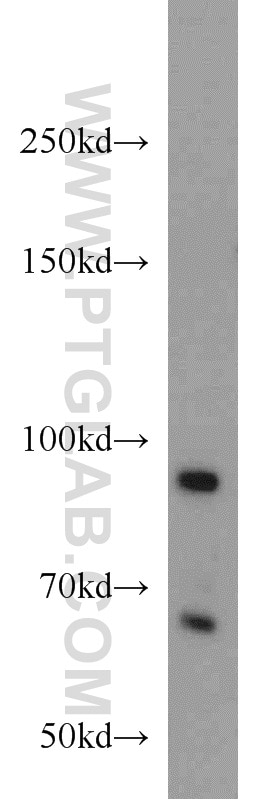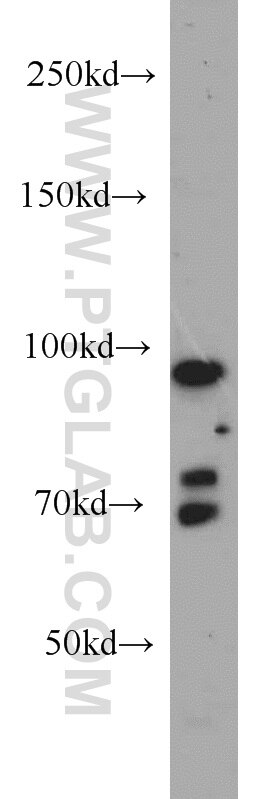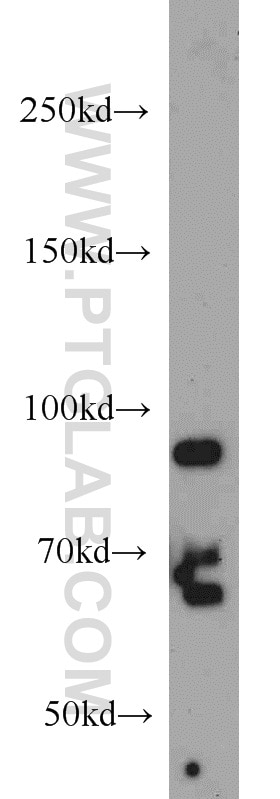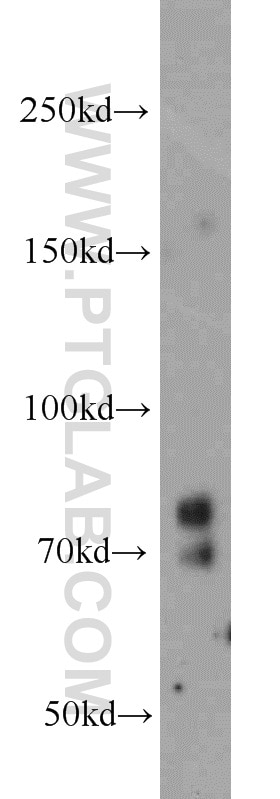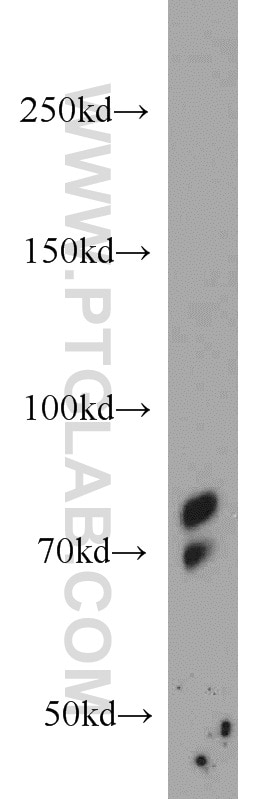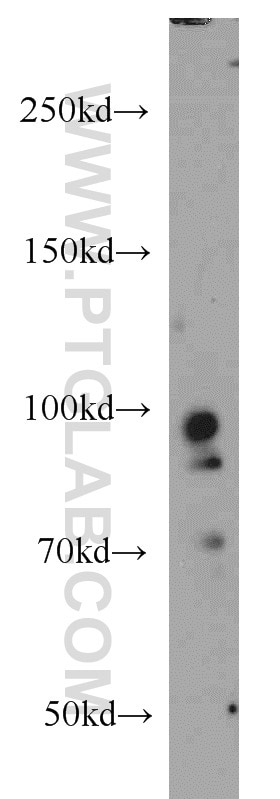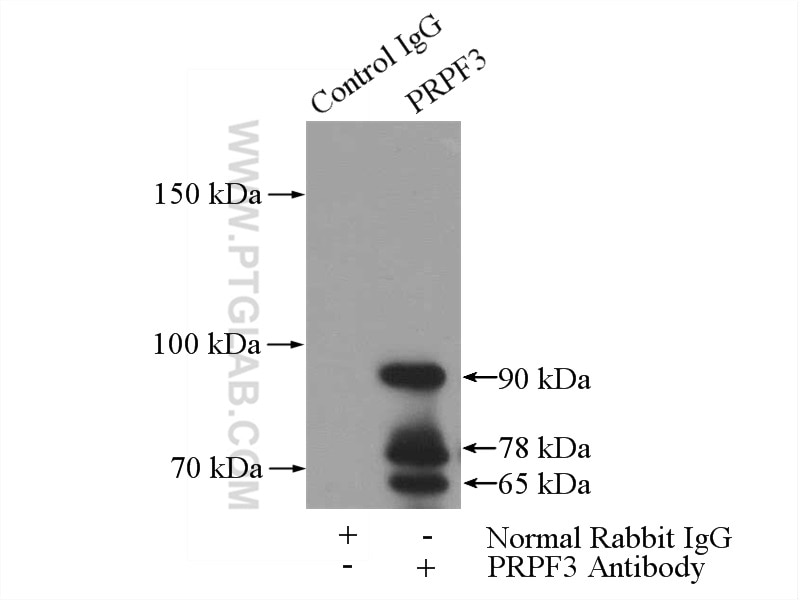PRPF3 Polyklonaler Antikörper
PRPF3 Polyklonal Antikörper für WB, IP, ELISA
Wirt / Isotyp
Kaninchen / IgG
Getestete Reaktivität
human, Maus, Ratte
Anwendung
WB, IP, IF, ELISA
Konjugation
Unkonjugiert
Kat-Nr. : 10106-1-AP
Synonyme
Galerie der Validierungsdaten
Geprüfte Anwendungen
| Erfolgreiche Detektion in WB | Y79-Zellen, HepG2-Zellen, L02-Zellen, Maushirngewebe, Mauslebergewebe |
| Erfolgreiche IP | Mauslebergewebe |
Empfohlene Verdünnung
| Anwendung | Verdünnung |
|---|---|
| Western Blot (WB) | WB : 1:500-1:2000 |
| Immunpräzipitation (IP) | IP : 0.5-4.0 ug for 1.0-3.0 mg of total protein lysate |
| It is recommended that this reagent should be titrated in each testing system to obtain optimal results. | |
| Sample-dependent, check data in validation data gallery | |
Veröffentlichte Anwendungen
| WB | See 3 publications below |
| IF | See 1 publications below |
Produktinformation
10106-1-AP bindet in WB, IP, IF, ELISA PRPF3 und zeigt Reaktivität mit human, Maus, Ratten
| Getestete Reaktivität | human, Maus, Ratte |
| In Publikationen genannte Reaktivität | human |
| Wirt / Isotyp | Kaninchen / IgG |
| Klonalität | Polyklonal |
| Typ | Antikörper |
| Immunogen | PRPF3 fusion protein Ag0154 |
| Vollständiger Name | PRP3 pre-mRNA processing factor 3 homolog (S. cerevisiae) |
| Berechnetes Molekulargewicht | 78 kDa |
| Beobachtetes Molekulargewicht | 90 kDa, 78 kDa |
| GenBank-Zugangsnummer | BC000184 |
| Gene symbol | PRPF3 |
| Gene ID (NCBI) | 9129 |
| Konjugation | Unkonjugiert |
| Form | Liquid |
| Reinigungsmethode | Antigen-Affinitätsreinigung |
| Lagerungspuffer | PBS mit 0.02% Natriumazid und 50% Glycerin pH 7.3. |
| Lagerungsbedingungen | Bei -20°C lagern. Nach dem Versand ein Jahr lang stabil Aliquotieren ist bei -20oC Lagerung nicht notwendig. 20ul Größen enthalten 0,1% BSA. |
Hintergrundinformationen
The pre-mRNA splicing occurs in spliceosomes, which consist of four ribonucleoprotein (snRNP) particles (U1, U2, U5 and U4/U6) and more than fifty proteins. This U4/U6-associated splicing factor, Hprp3p, is a 77 kDa protein, which is homologous to the Saccharomyces cerevisiae splicing factor Prp3p and may play a role in spliceosome assembly. Western blot analysis of HeLa cell nuclear extracts detected PRP3 protein at an apparent molecular mass of about 90 kD(PMID: 9328476 ). The discrepancy between the molecular mass reported here and that predicted from the Hprp3p coding sequence can be attributed, at least partially, to the highly positive charge; its value of predicted isoelectric point (IP) is ∼9.99. This antibody is a rabbit polyclonal antibody raised against an internal region of human PRPF3. A predicted molecular mass of 77 kDa and the gene is named PRPF3 because it is homologous to the yeast PRP3 gene. We noticed that although the predicted molecular mass of PRPF3 is77 kDa, the protein produced in E.coli migrated like a 90 kDa protein in SDS-PAGE. (PMID: 9328476)
Protokolle
| Produktspezifische Protokolle | |
|---|---|
| WB protocol for PRPF3 antibody 10106-1-AP | Protokoll herunterladen |
| IP protocol for PRPF3 antibody 10106-1-AP | Protokoll herunterladen |
| Standard-Protokolle | |
|---|---|
| Klicken Sie hier, um unsere Standardprotokolle anzuzeigen |
Publikationen
| Species | Application | Title |
|---|---|---|
Hum Mol Genet PRPF mutations are associated with generalized defects in spliceosome formation and pre-mRNA splicing in patients with retinitis pigmentosa. | ||
Mol Cell Biol A quantitative high-throughput in vitro splicing assay identifies inhibitors of spliceosome catalysis. | ||
J Biol Chem PRPF19 regulates p53-dependent cellular senescence by modulating alternative splicing of MDM4 mRNA. | ||
Cell Mol Biol Lett TMEM43 promotes pancreatic cancer progression by stabilizing PRPF3 and regulating RAP2B/ERK axis. |
